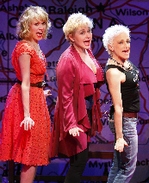SITE GUIDE
SEARCH
REVIEWS
REVIEW ARCHIVES
ADVERTISING AT CURTAINUP
FEATURES
NEWS
Etcetera and
Short Term Listings
LISTINGS
Broadway
Off-Broadway
NYC Restaurants
BOOKS and CDs
OTHER PLACES
Berkshires
London
California
New Jersey
DC
Connecticut
Philadelphia
Elsewhere
QUOTES
TKTS
PLAYWRIGHTS' ALBUMS
LETTERS TO EDITOR
FILM
LINKS
MISCELLANEOUS
Free Updates
Masthead
A CurtainUp Review
Good Ol' Girls
|
You see the range from childhood to the nursing home. You can see your mother, your aunts, all the women you have known and loved. You can see yourself. ——Jill McCorkle It's a show about attitude, about having a spunky approach to life. — Lee Smith |

Lauren Kennedy, Sally Mayes, Gina Stewrt
(Photo: Carol Rosegg) |
Just what are Good Ol' Girls ? Says the opening song, "Her heart is kind, oh, but she speaks her mind.". And she has big hair because, "With her hair that piled up, she feels closer to God. That's a good ol' girl.".
Paul Ferguson adapted stories by two notable Southern writers, Lee Smith and Jill McCorkle and formed a fast moving revue of brief anecdotes and catchy tunes, the Nashville story songs that reflect feelings from a mixture of tradition and passions. There is not much of a plotline, no defined characters, just sassy survivors who keep the ninety-minute show moving. In this disconnected pattern of stories and songs, each woman has tells something personal of how she got here, her hopes and disappointments.
While one woman sings, the others listen to her, nod sympathetically, and occasionally sing backup. All together, they share memories like "Back When We Were Beautiful," the battle against aging as beauty slips away, and voice the optimism in "All I Want Is Everything." The one performance disappointment is Gina Stewart's uninspired rendition of "Booze in Your Blood" which should be a rousing powerhouse.
Sally Mayes stands out, portraying a character who's vulnerable yet plucky. She has the most dramatic segments, beginning as a teenager who got pregnant. When her mother told her she was "ruined" the girl decided she'd go out and have a good time because, "If you're ruined like I was, it frees you up some." Mayes also effectively shares the emotion and pain of giving birth and the joy that her baby now gives her. The most touching moment shows Mayes, a beautician, going to the funeral parlor to fix the makeup and hair for her mother who just died.
Unlike the drama, Steel Magnolias or musical revue, Pump Boys and Dinettes with similar characters, the episodic Good Ol' Girls is a half-breed of cabaret and theater. The stage is a raised platform. There is no set time or place. The women walk in dressed in down-home casual clothes and props are minimal with some chairs, benches, guitars, bottles of Pabst. Four spirited musicians play behind a scrim on stage.
All the creatives here are familiar with the country genre. Songwriter Matraca Berg was inspired by Lee Smith's stories and contacted fellow Nashville songwriter Marshall Chapman about creating a musical version. Smith called writer Jill McCorkle to join in. The resulting Good Ol' Girls was first produced in 1999 with two acts. This version is shorter and kept at a brisk pace by director Randal Myler who certainly knows the genre though this production seems rushed and abbreviated. While the songs add a regional flavor and the experiences are familiar, the characters are not fleshed out and the women show no evidence of close friendships. At the end, we glimpse snapshots rather than journeys, and there is not enough to evoke the emotions of universality.
|
Good Ol' Girls Based on stories of Lee Smith and Jill McCorkle Cast: Lauren Kennedy, Sally Mayes, Teri Ralston, Gina Stewart, Liza Vann Directed by Randal Myler Songs: Matraca Berg and Marshall Chapman Musical Supervisor/Orchestrations: Keith Levenson Music Director: Karen Dryer Music Adaptation and Arrangements: Joe Newberry and Julie Oliver Sets Design: Timothy Mackabee Costume Design: Michael Bevins Lighting Design: Brian Nason Sound Design: Lew Mead Running Time: 1 hour, 30 minutes. No intermission Block Box Theatre at The Harold and Miriam Steinberg Center for Theatre: 111 West 46th Street Tickets: $70. ($85 premium). (212) 352-3101 or (866) 811-4111 or www.theatermania.com. For group sales of 10 or more, (212) 265-8500 or www.theatre4groups.com. Performances: Mondays, Tuesdays, Friday and Saturday at 8PM. Matinees Wednesdays, Saturdays and Sundays at 3pm. From 02/08/10. Opening 02/14//10. Closing 04/11/10. Review by Elizabeth Ahlfors based on performance 02/13/10. |
|
REVIEW FEEDBACK Highlight one of the responses below and click "copy" or"CTRL+C"
Paste the highlighted text into the subject line (CTRL+ V): Feel free to add detailed comments in the body of the email. . .also the names and emails of any friends to whom you'd like us to forward a copy of this review. You can also contact us at Curtainup at Facebook , Curtainup at Twitter and at our Blog Annex |
|
Subscribe to our FREE email updates with a note from editor Elyse Sommer about additions to the website -- with main page hot links to the latest features posted at our numerous locations. To subscribe,
E-mail: esommer@curtainup.comesommer@curtainup.com
put SUBSCRIBE CURTAINUP EMAIL UPDATE in the subject line and your full name and email address in the body of the message -- if you can spare a minute, tell us how you came to CurtainUp and from what part of the country. |





